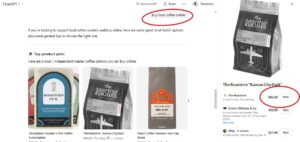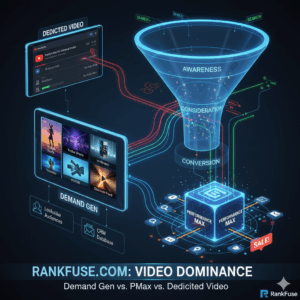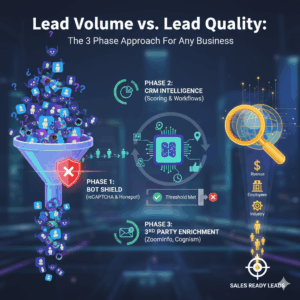Starting a business with limited resources doesn’t mean you have to lose the SEO game before you even begin. While big brands dominate the obvious keywords, there’s a goldmine of opportunities they’re completely ignoring.
In this step-by-step guide, we’ll teach you how to build a winning content strategy using AI tools, giving you the opportunity to crush SEO even with a $0 budget.
The Reality Check: Why Traditional SEO Advice Doesn’t Work for Startups
Big brands have inherent SEO advantages that most startup SEO planning conveniently ignores. They possess massive domain authority built over decades, with thousands of dollars invested in top-tier agencies and in-house talent. Additionally, they have resources to pump out endless content, and have established communities and social followers to build backlinks effortlessly.
They can focus their aim and rank easily for competitive keywords like “email marketing” or “project management software” simply because Google trusts their domain, content, and legacy that emerging brands can’t build overnight.
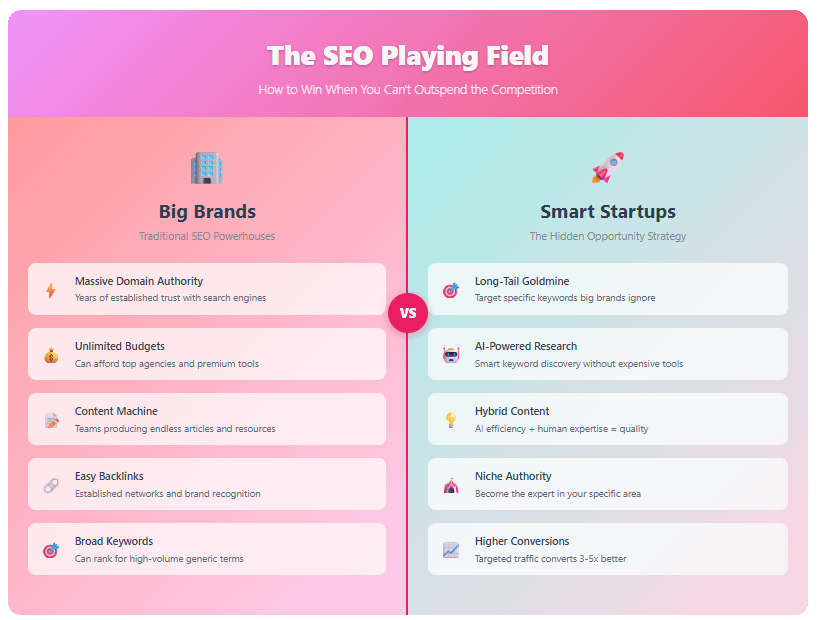
But, here’s what they can’t do efficiently: target the thousands of highly specific, long-tail keywords that your ideal customers are actually searching for. These keywords might have lower search volumes, but they represent buyers who know exactly what they want and are ready to purchase.
Step 1: The AI Keyword Research Revolution
Traditional keyword research tools (the good ones) can cost hundreds of dollars monthly and often miss the nuanced, conversational searches your customers make. Furthermore, Google’s obsession with broad match keywords and PMAX ad campaigns makes leveraging paid search keyword data for SEO an advanced skill set. This is another topic for another blog post.
Instead, leverage AI to uncover these hidden gems. Start by asking your preferred AI tool: “Generate 50 long-tail keywords for [your niche] that combine specific use cases, customer types, industry verticals, and pain points.“
For example, if you’re in the email marketing space, instead of getting generic suggestions, you’ll discover keywords like “email automation for dental practices” or “newsletter templates for fitness coaches.” These keywords have genuine buyer intent because they’re incredibly specific.
Here’s the crucial part: most suggestions won’t be gold. Be ruthlessly selective. Look for keywords that match three criteria:
- They sound like something your ideal customer would actually search
- They have clear commercial intent
- They’re specific enough that big brands won’t bother targeting them.
Step 2: Scale Your Keyword Discovery
Once you’ve identified 10 to 15 solid keywords, it’s time to multiply your research exponentially. Take your best examples back to your AI tool with this prompt: “These are great examples of long-tail keywords in my niche. Generate 50 more following the same pattern.“
AI excels at pattern recognition. It will analyze what makes your successful keywords work and generate variations that follow the same structure. You might discover “automated welcome sequences for yoga studios,” “drip campaigns for online course creators,” or “retention emails for subscription boxes.”
Repeat this process until you have 100+ targeted keywords. This approach gives you a content calendar that could last months while targeting searches your competitors aren’t even aware exist.
Scale Your Keyword Discovery
From 10 Good Keywords to 100+ Goldmine
Start with Your Winners
Identify 10-15 solid long-tail keywords that match your three success criteria: realistic to rank for, clear buyer intent, and specific enough to convert.
AI Pattern Recognition Magic
AI excels at spotting what makes your successful keywords work. It analyzes structure, identifies patterns, and understands the winning formula.
🧠 What AI Discovers in Your Keywords
Watch the Multiplication
Each iteration generates dozens of new, high-quality keywords following your proven patterns. What took hours of manual research now happens in minutes.
AI-Generated Variations:
Rinse and Repeat
Continue the process until you have a content calendar that could last months. Each iteration builds on the previous, creating increasingly targeted opportunities.
Select Best
Choose top 15-20 from each batch
Feed Back to AI
Use winners as new pattern examples
Generate More
Get 50+ new variations each round
Build Library
Create months of content ideas
Keyword Growth Over Iterations
🚀 The End Result
From a handful of good keywords to a complete content strategy
Pure gold keywords that big brands ignore but your ideal customers are actively searching for
Step 3: Target Keywords That Actually Convert
Keyword selection can be the difference between wasting time and building a business. Instead of chasing impossible terms like “email marketing software,” focus on the long-tail variations that indicate purchase readiness.
Consider these transformations:
- “Email marketing” becomes “email templates for yoga studios.”
- “CRM software” becomes “client management for freelance designers.”
- “Social media tools” becomes “Instagram scheduler for restaurants”
These specific keywords serve customers who’ve moved past general research into solution-seeking mode. They know their industry, understand their problem, and need a targeted solution.
Big brands ignore these because the search volumes appear small, but conversion rates are typically three to five times higher than generic terms.
Strategy Examples
See the Difference: Generic vs Targeted Approach
🎯 Keyword Targeting Strategy
Compare how big brands approach keywords vs. the smart startup strategy that targets buyer-intent long-tail keywords.
- High search volume
- Brand awareness potential
- Extremely difficult to rank
- Low conversion intent
- Massive competition
- Easy to rank
- High conversion rate
- Specific buyer intent
- Low competition
- Lower search volume
Step 4: Create Content That Actually Ranks
Most people approach AI content creation completely wrong. They type “Write me a 2000-word article about email marketing,” copy the output, paste it directly to their blog, and wonder why it doesn’t rank or convert.
This approach produces generic content that provides no unique value. Google’s algorithms can detect AI-generated content that lacks human insight, and your audience certainly can tell the difference. Instead, you should write engaging website content that converts because it targets humans first.
📝 Content Creation Methods
See how the hybrid AI approach creates superior content compared to traditional AI copy-paste methods.
- No unique value
- Generic examples
- Outdated information
- Poor search rankings
- Low engagement
- Ranks #3 for target keyword
- 4x higher engagement
- Real case studies
- Industry-specific advice
- Higher conversion rate
- Generic pitch
- No specific value
- 95% rejection rate
- 45% response rate
- Specific expertise shown
- Real value offered
- Industry relevance
Step 5: The Hybrid AI Content Process
The winning approach treats AI as your research assistant and draft creator, not your replacement. Here’s the system that actually works:
- Set Up Your AI Workspace: Create a dedicated project in Claude or your preferred AI tool. This allows you to maintain context across multiple conversations and build upon previous work.
- Feed It Your Best Content: Upload examples of your highest-performing content, whether that’s blog posts, email newsletters, or social media content that generated engagement. This teaches the AI your voice and approach.
- Upload Competitor Research: Analyze three to five pieces of content from competitors ranking for your target keywords. Don’t copy their approach, but understand what elements Google rewards in your niche.
- Define Your Brand Voice: Provide clear guidelines about your tone, expertise level, and unique perspective. Are you conversational or formal? Do you use industry jargon or plain language? What makes your approach different?
- Generate Section by Section: Never ask for complete articles. Instead, work through each section individually, allowing you to guide the direction and add your expertise throughout the process.
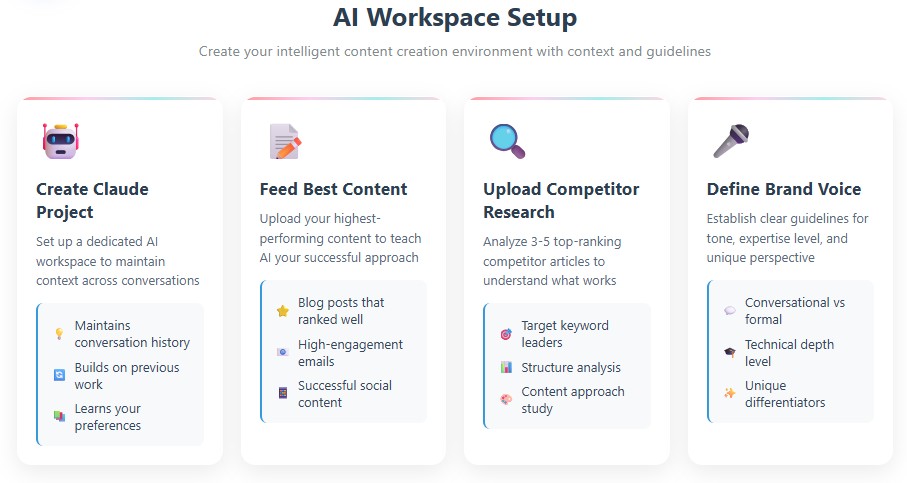
Step 6: Section-By-Section Content Creation
For each major section of your content, provide specific instructions: “Write about [topic] and include real examples, specific steps, current data, and industry context.”
But most people stop here, and this is where you need to add the magic: make every section uniquely yours.
Add your personal experience and insights that only come from actually doing the work. Include case studies from your own projects or client work, even if the scale is small. Share actual results with specific numbers and outcomes. Reference recent industry changes or updates that show you’re actively engaged in your field.
This hybrid approach gives you the efficiency of AI with the authenticity and expertise that search engines and readers value.
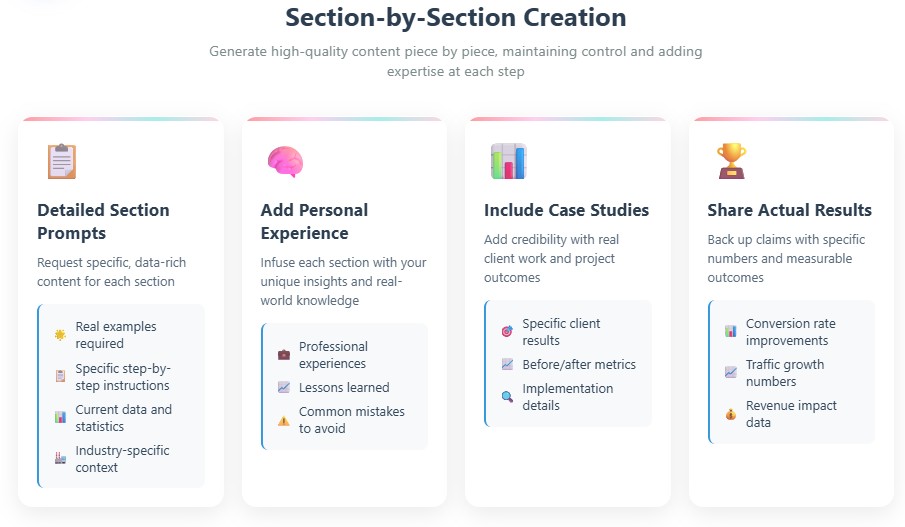
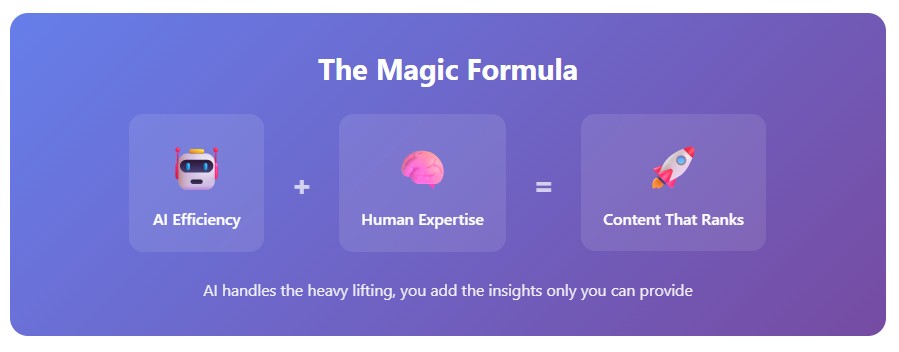
Step 7: Build Backlinks with Zero Budget Using the Expert Persona Strategy
Most backlink strategies assume you have an established brand or budget for outreach tools. The Expert Persona Strategy builds authority from the ground up.
Create Your Professional Foundation: Set up a professional email address using your domain ([name]@[yourdomain.com]). Craft a compelling expert bio highlighting your specific expertise and unique angle.
Invest in a professional headshot or high-quality photo that positions you as a credible authority and is consistent in email, social media, etc. Never use Gmail or another free email service, as this is an immediate red flag. Your job here is to separate yourself from others. If you fail here, you get filtered in a sea of similar email requests, and the rest of the steps don’t matter.

Establish Your Authority Base: Before reaching out to other sites, publish three to five high-quality, in-depth articles on your own blog. These serve as proof of your expertise and writing ability when you pitch guest posts.
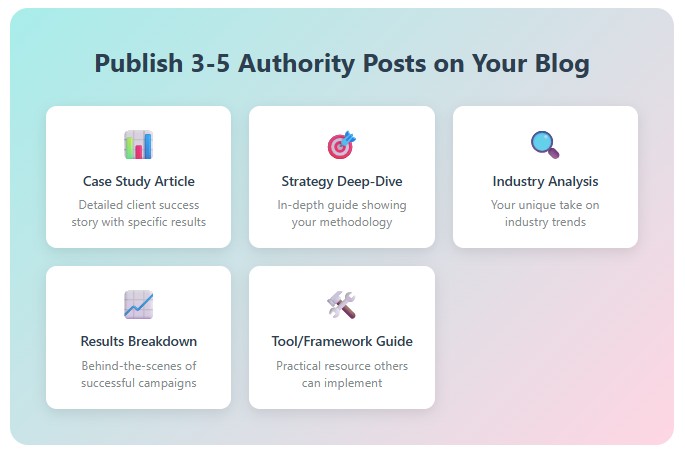
Target the Right Publications: Find 50+ small to medium-sized blogs in your niche. These sites need quality content and are more likely to accept contributions from emerging experts. Use advanced Google searches like “write for us” + [your industry] or “guest post guidelines” + [your niche].
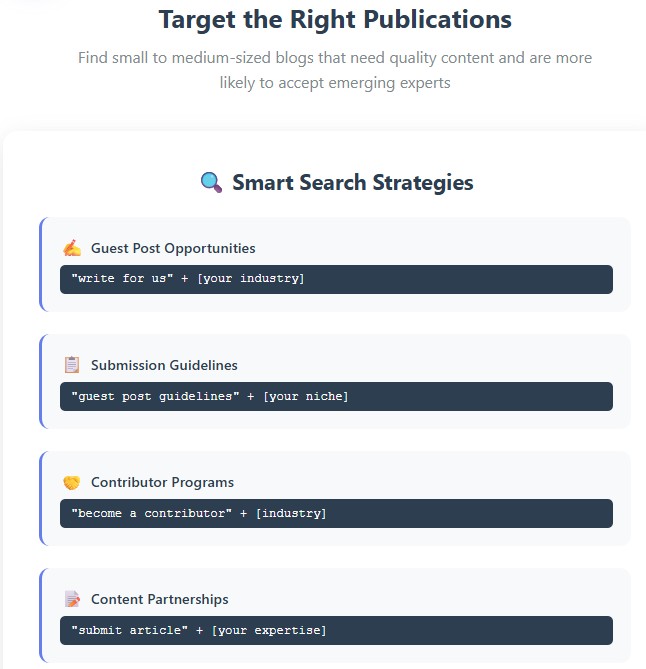
Craft Personalized Pitches: Generic outreach fails. Reference specific articles from their site, explain why your topic would interest their audience, and propose content that genuinely adds value to their readers.
If you’re just starting out, build credibility with smaller sites first. A guest post on a niche blog with 5,000 engaged readers often provides more value than being rejected by major publications.
Step 8: The Complete Process in Action
Here’s your complete roadmap:
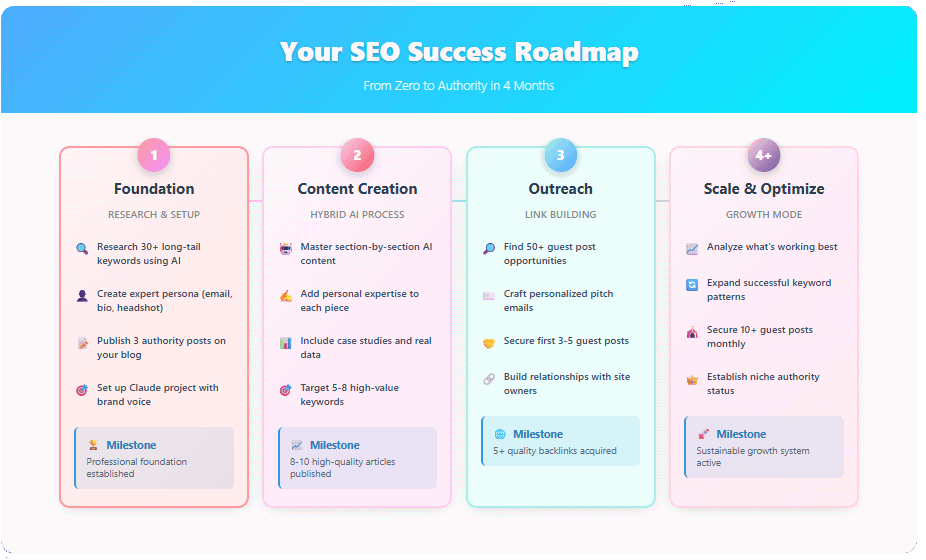
Month 1 – Foundation: Research and compile 30+ long-tail keywords using the AI method described above. Create your expert persona, including a professional email, bio, and headshot. Publish your first three authority posts on your own blog.
Months 2 to 3 – Content Creation: Use the hybrid AI process to create in-depth content targeting your researched keywords. Focus on quality over quantity—to to three comprehensive pieces often outperform 10 shallow articles.
Months 4 and Beyond – Link Building and Scale: Begin outreach for guest posting opportunities. Aim to secure 10+ guest posts over the next few months. Each guest post should target one of your researched keywords and link back to relevant content on your site.
Ongoing – Rinse and Repeat: Expand your keyword research, create more content, and continue building relationships with other site owners in your niche.
The Bottom Line
Building SEO authority doesn’t require a massive budget—it requires strategic thinking and consistent execution.
By targeting the long-tail keywords big brands ignore, using AI as an intelligent assistant rather than a replacement, and building genuine expertise in your niche, you can compete effectively against much larger competitors.
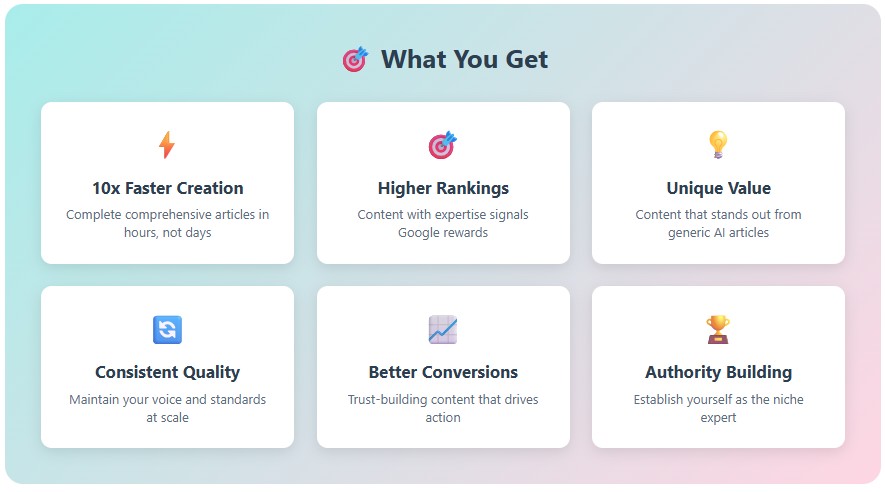
The businesses that will win in 2025 won’t necessarily have the biggest budgets. They’ll be the ones that understand how to leverage AI tools effectively while maintaining the human insight and expertise that creates real value for their audience.
Your competitive advantage isn’t trying to outspend the big players—it’s being smart enough to play a different game entirely.

